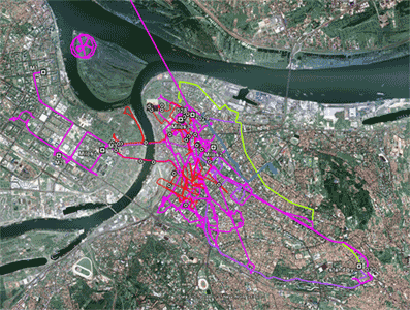
DigitGroup Belgrade, Rhizome of the City, map, 2010.
The Rhizome of the City project employs a layered formalization of decisions, choices, preferences, observations, interactions and compromises that constitute urban experience in order to acknowledge its symbolism and to refresh the potential of micro-narratives for modifying the existent and establishing the new identity profile of the city.
The GPS and the Internet provide a complex drawing visualization of the subjective perception and interpretation of urban identity that, in case of Belgrade, may be considered as highly problematic. This is very well reflected in a discrepancy between the dynamic, media-projected image of Belgrade and the actual, often frustrating and sometimes traumatic everyday experiences of its citizens with even slightly elaborated agendas. The life of Serbian capital traditionally takes place in a discord of its Levantine dysfunctionality and rudimentary civic awareness of its inhabitants with the key relations that constitute a city, the ultimate consequences of which were defined by the Modernist concept of the City as a machine for efficient life.
Belgrade is certainly just one among many contemporary examples of urban agglomeration. In a majority of large cities, the impression of comfort is affordable only to those who balance their material and financial status with their perceptual, cognitive and ethical self-censorship. But the paths drawn by the artists in Rhizome of the City are also censored by technology, by spatial disposition and by traffic (most quirks are the result of GPS errors), indicating that the main urban activities such as motion, consumption and communication are being predominantly reduced to a selection from the set of predefined options. This phenomenon is symptomatic not only for urban life but for modern culture in general, in which the conventions are created as a combination of voluntary submission and opportunistic lack of resistance.
Thus the identity, which Rhizome of the City directly addresses, is today largely established by acquiring the existing models and symbolic systems, and rarely through individual experience. Manuel Castells notes that “[in] a world of global flows of wealth, power, and images, the search for identity, collective or individual, ascribed or constructed, becomes the fundamental source of social meaning. This is not a new trend, since identity, and particularly religious and ethnic identity, has been at the roots of meaning since the dawn of human society. Yet identity is becoming the main, and sometimes the only, source of meaning in an historical period characterized by widespread destructuring of organizations, delegitimation of institutions, fading away of major social movements, and ephemeral cultural expressions. People increasingly organize their meaning not around what they do but on the basis of what they are, or believe they are. Meanwhile, on the other hand, global networks of instrumental exchanges selectively switch on and off individuals, groups, regions, and even countries, according to their relevance in fulfilling the goals processed in the network, in a relentless flow of strategic decisions. There follows a fundamental split between abstract, universal instrumentalism, and historically rooted, particularistic identities. Our societies are increasingly structured around a bipolar opposition between the Net and the self.”[1]
In this opposition, contemporary critical discourse often recognizes the principle of rhizomatic decentralization, indicated in Anti-Oedipus and elaborated in A Thousand Plateaus by Gilles Deleuze and Félix Guattari, as a promising concept that can be achieved by the use of digital technology, especially the Internet.[2] The understanding of the Internet as a free, uncontrollable, rhizome-like structure,[3] however, ignores its contradictory nature that includes both decentralization (TCP/IP, distribution) and control (DNS, commercialization, homogenization).[4] By exploring and æstheticizing the space of contact between horizontal-rhizomatic and vertical-hierarchical aspects of digital networking, Rhizome of the City prompts its participants and its audience to recognize their own positions and to assume clear attitudes towards that space. It propounds the new methodology for mental hybridization of (urban) identity, for its symbolic representation and communication, indirectly affirming the significance of a mainly neglected or exploited notion that politics, before it becomes public, is always personal, intimate matter.
-
Manuel Castells, The Rise of the Network Society (2nd ed.), Wiley-Blackwell, Chichester, 2010, p. 3. ↩
-
Charlie Gere, Digital Culture (2nd ed.), Reaktion Books, London, 2008, pp. 161-165. ↩
-
Julian Stallabrass, Internet Art: The Online Clash of Culture and Commerce, Tate, London, 2003, p. 23. ↩
-
Alexander Galloway, Protocol, MIT Press, Boston, 2006, pp. 8-10. ↩
DigitGroup Belgrade, Rhizome of the City, project catalogue, Museum of Science and Technology, Belgrade, 2010
New Technologies 2010 exhibition catalogue, Gallery of Contemporary Art, Cultural Center of Pančevo, Pančevo, 2010, ISBN 978-86-87103-29-0, pp. 10-12.